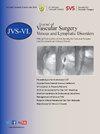超声造影对慢性髂静脉阻塞诊断准确性的评价。
IF 2.8
2区 医学
Q2 PERIPHERAL VASCULAR DISEASE
Journal of vascular surgery. Venous and lymphatic disorders
Pub Date : 2025-02-20
DOI:10.1016/j.jvsv.2024.102001
引用次数: 0
摘要
目的:慢性髂静脉阻塞的无创诊断具有挑战性。目前有多种无创方法,但各有优缺点。血管内超声(IVUS)被认为是诊断的参考标准,但它具有侵入性。造影剂增强超声检查在慢性髂静脉阻塞中的作用至今尚未研究:这是一项单中心回顾性研究。方法:这是一项单中心回顾性研究,39 名疑似慢性髂静脉阻塞的患者在同一天接受了未增强超声造影、Lumason 对比增强超声造影和 IVUS 检查:结果:大部分数据集为女性,有血栓后病变,属于 CEAP C4 级或以上。增强型和非增强型超声波检查的类内相关系数(kappa,平均测量值)为 0.9(95% 置信区间 [CI],0.87-0.92),表明两者的一致性非常好。然而,增强型超声造影与 IVUS 之间的相关系数为 0.6(95% 置信区间 [CI],0.16-0.67),未增强型超声造影与 IVUS 之间的相关系数为 0.5(95% 置信区间 [CI],0.37-0.75),表明两者之间的一致性较差。将 IVUS 作为参考标准,使用和未使用 Lumason 的髂外静脉超声诊断准确率分别为 71.3% 和 71.4%。与IVUS相比,使用和未使用鲁马森的髂总静脉超声诊断准确率分别为53.2%和56.7%:结论:在诊断慢性髂静脉阻塞时,对比增强超声造影和未增强超声造影与IVUS等参考标准相比,诊断准确性的衡量标准相似。还需要进一步研究,以明确对比增强超声造影在诊断慢性髂静脉阻塞方面的辅助价值。本文章由计算机程序翻译,如有差异,请以英文原文为准。
Evaluation of the diagnostic accuracy of contrast enhanced ultrasonography in chronic iliac venous obstruction
Objective
The noninvasive diagnosis of chronic iliac vein obstruction can be challenging. Noninvasive modalities are available, but each has its own merits and drawbacks. Intravascular ultrasound (IVUS) is considered the diagnostic reference standard, but it is invasive. The role of contrast-enhanced ultrasonography in chronic iliac vein obstruction has so far not been studied.
Methods
This is a single-center retrospective study. Thirty-nine patients, suspected to have chronic iliac venous obstruction, underwent unenhanced ultrasonography, contrast-enhanced ultrasonography with Lumason, and IVUS on the same day.
Results
Most of the data set was female, had post thrombotic lesions, and belonged to CEAP Class C4 or higher. The intraclass correlation coefficient (kappa, average measures) between enhanced and unenhanced ultrasonography was 0.9 (95% confidence interval [CI], 0.87-0.92), indicative of very good agreement. However, the correlation coefficients between enhanced ultrasonography and IVUS and unenhanced ultrasonography and IVUS were 0.6 (95% CI, 0.16-0.67) and 0.5 (95% CI, 0.37-0.75), respectively, indicative of less optimal agreement. Considering IVUS as the reference standard, diagnostic accuracies for ultrasonography for external iliac vein with and without Lumason use were 71.3% and 71.4%, respectively. Diagnostic accuracies for ultrasonography for common iliac vein with and without Lumason use were 53.2% and 56.7%, respectively, when compared with IVUS.
Conclusions
The measures of diagnostic accuracy of contrast-enhanced ultrasonography and unenhanced ultrasonography are similar to each other in the diagnosis of chronic iliac vein obstruction when compared with a reference standard such as IVUS. Further studies are needed to delineate the complimentary value of contrast-enhanced ultrasonography in the diagnosis of chronic iliac vein obstruction.
求助全文
通过发布文献求助,成功后即可免费获取论文全文。
去求助
来源期刊

Journal of vascular surgery. Venous and lymphatic disorders
SURGERYPERIPHERAL VASCULAR DISEASE&n-PERIPHERAL VASCULAR DISEASE
CiteScore
6.30
自引率
18.80%
发文量
328
审稿时长
71 days
期刊介绍:
Journal of Vascular Surgery: Venous and Lymphatic Disorders is one of a series of specialist journals launched by the Journal of Vascular Surgery. It aims to be the premier international Journal of medical, endovascular and surgical management of venous and lymphatic disorders. It publishes high quality clinical, research, case reports, techniques, and practice manuscripts related to all aspects of venous and lymphatic disorders, including malformations and wound care, with an emphasis on the practicing clinician. The journal seeks to provide novel and timely information to vascular surgeons, interventionalists, phlebologists, wound care specialists, and allied health professionals who treat patients presenting with vascular and lymphatic disorders. As the official publication of The Society for Vascular Surgery and the American Venous Forum, the Journal will publish, after peer review, selected papers presented at the annual meeting of these organizations and affiliated vascular societies, as well as original articles from members and non-members.
 求助内容:
求助内容: 应助结果提醒方式:
应助结果提醒方式:


